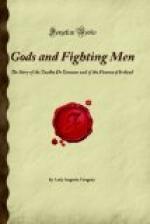“The body of Gaelic literature connected with the name of Ossian is of very considerable extent and of respectable antiquity. The oldest texts, prose for the most part, but also in verse, are preserved in Irish MSS. of the eleventh and twelfth centuries, and go back to a period from one hundred and fifty to two hundred and fifty years older at least. The bulk of Ossianic literature is, however, of later date as far as the form under which it has come down to us is concerned. A number of important texts, prose for the most part, are preserved in MSS. of the fourteenth century, but were probably redacted in the thirteenth and twelfth centuries. But by far the largest mass consists of narrative poems, as a rule dramatic in structure. These have come down to us in MSS. written in Scotland from the end of the fifteenth to the middle of the seventeenth century, in Ireland from the sixteenth down to the middle of the nineteenth century. The Gaelic-speaking peasantry, alike in Ireland and Scotland, have preserved orally a large number of these ballads, as also a great mass of prose narratives, the heroes of which are Ossian and his comrades.
“Were all Ossianic texts preserved in MSS. older than the present century to be printed, they would fill some eight to ten thousand octavo pages. The mere bulk of the literature, even if we allow for considerable repetition of incident, arrests attention. If we further recall that for the last five hundred years this body of romance has formed the chief imaginative recreation of Gaeldom, alike in Ireland and Scotland, and that a peasantry unable to read or write has yet preserved it almost entire, its claims to consideration and study will appear manifest.”
He then goes on to discuss how far the incidents in the stories can be accepted as they were accepted by Irish historical writers of the eleventh century as authentic history:—
“Fortunately there is little need for me to discuss the credibility or otherwise of the historic records concerning Finn, his family, and his band of warriors. They may be accepted or rejected according to individual bent of mind without really modifying our view of the literature. For when we turn to the romances, whether in prose or verse, we find that, although the history is professedly the same as that of the Annals, firstly, we are transported to a world entirely romantic, in which divine and semi-divine beings, ungainly monsters and giants, play a prominent part, in which men and women change shapes with animals, in which the lives of the heroes are miraculously prolonged—in short, we find ourselves in a land of Faery; secondly, we find that the historic conditions in which the heroes are represented as living do not, for the most part, answer to anything we know or can surmise of the third century. For Finn and his warriors are perpetually on the watch to guard Ireland against the attacks of over-sea raiders, styled Lochlannac by the narrators, and by them undoubtedly




